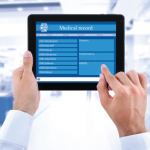- B—No. Although the documentation states the patient arrived at the clinic at 8:15 a.m. and left the clinic at 10:55 a.m., it does not document the actual start and stop times of the infusion. According to CPT, when reporting codes for which infusion time is a factor, use the actual time over which the infusion is administered. Medicare considers this as “drip to drip”; documentation of time begins when the medication starts and ends at the time of completion of the medication.
- D—A and B. 20611—Arthrocentesis, aspiration and/or injection, major joint or bursa (e.g., shoulder, hip, knee, subacromial bursa); with ultrasound guidance, with permanent recording and reporting. There must be documentation of whether the left or right knee was injected and if performing a joint injection via ultrasound guidance; there must be permanent recording and documentation to that effect. The E/M visit would be a Level 4 visit, as the history was detailed, the exam was expanded problem focused and the medical decision making was moderate complexity. This was an established patient, so only two of the three of the history, exam or medical decision making are needed.
- D—All of the above. In order to get to the ICD-10 code M16.11—Unilateral primary osteoarthritis, right hip, there must be documentation of the following three items:
- The type of osteoarthritis (e.g., primary, secondary or post-traumatic);
- Anatomical site (e.g., hip, knee, shoulder, etc.); and
- Location (e.g., right or left).
The E/M visit would be a Level 4 visit, as the history was detailed, the exam was expanded problem focused and the medical decision making was moderate complexity. This was an established patient, so only two of the three of the history, exam or MDM are needed.
- D—A and C. When counseling and/or coordination of care dominates (more than 50%) the physician–patient and/or family encounter (face-to-face time in the office or other outpatient setting), time is considered the key or controlling factor to qualify for a particular level of E/M services. Documentation guideline: If the physician elects to report the level of service based on counseling and/or coordination of care, the total length of time of the encounter (face to face, as appropriate) should be documented, and the record should describe the counseling and/or activities to coordinate care:
- The total time of the visit;
- More than 50% of the visit was spent face-to-face counseling and/or coordinating the care of the patient; and
- What was discussed during the counseling and/or coordination of care.
- E—The chief complaint for the follow-up visit. All payers require a reason for every encounter, even if the patient is only seen for a procedure. Without a valid chief complaint, some carriers may consider the visit as not medically necessary. The codes for the encounter would be 96401 and J9250x2.


